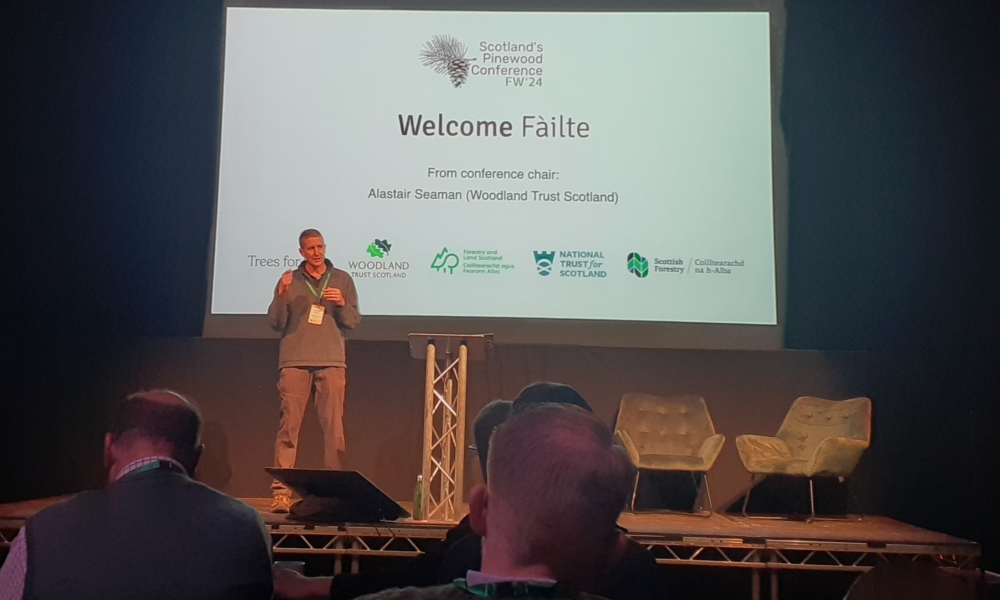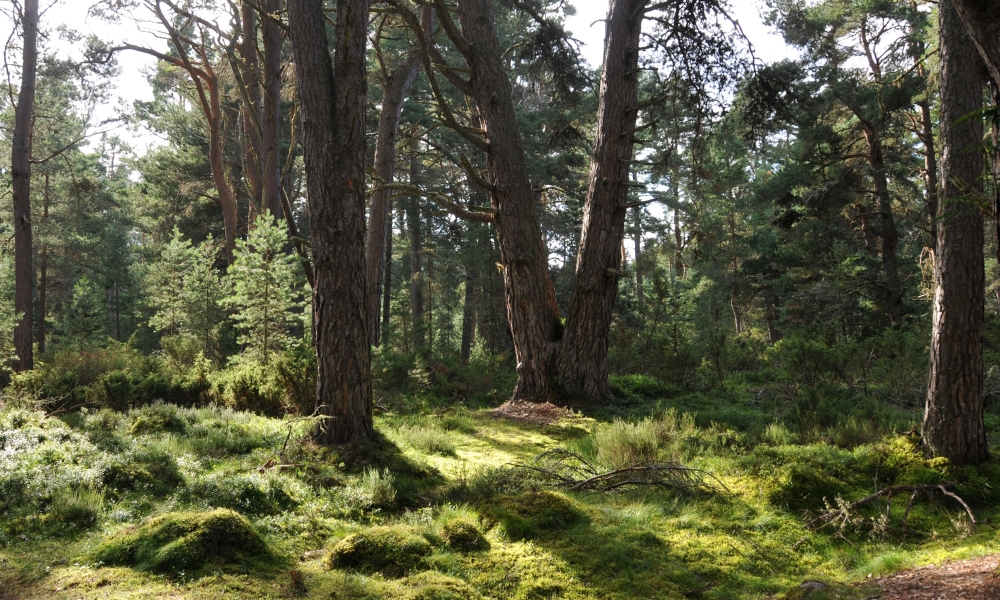Scotland’s Pinewood: Ancient roots - Modern challenge by David Broom
13.12.24Scotland’s Pinewood: Ancient roots - Modern challenge by David Broom
Fort William – 28th and 29th October
A conference to celebrate Scotland’s Caledonian Pinewoods was held on October 28th and 29th in Fort William, organised and supported by Forestry and Land Scotland, Jahama Highland Estates, John Muir Trust, National Trust for Scotland, NatureScot, Native Woodland Discussion Group, Nevis Landscape Partnership, RSPB Scotland, Scottish Forestry, Trees for Life, Botanæco and Woodland Trust Scotland.
I attended the conference, not as an owner or manager of an area of Caledonian Pinewood, but as an enthusiast of these fabulous upland wildlife habitats and distinctive elements of the Scottish upland landscape. I hoped to get an update on current priorities and action for the conservation of Caledonian Pinewoods so that I could pass this onto Association members who might share my interest in these extraordinary places, and in turn inform others about the special qualities, threats and priorities for Caledonian Pinewood conservation.
The conference comprised a series of presentations by representatives of several key organisations involved with the conservation of Caledonian Pinewoods, including the National Trust for Scotland, Trees for Life, Forestry and Land Scotland, and St Andrews University. Field trips to key Pinewood conservation sites were held during the afternoon of the first day of the conference, followed by a conference dinner and an evening of spellbinding live music and poetry – In Search of the Lost Pines, with poetry written especially for the conference. Around 150 delegates attended the conference in person, and around 150 delegates attended an on-line version. Virtual field trips had also been prepared for delegates who could not attend in person. A workshop programme was organised that covered a range of key topics and issues concerning priorities for conservation management within Scotland’s Caledonian Pinewoods.
This was a great event. The talks were delivered by eminent speakers involved with some of the most critical current Pinewood conservation and research projects, and gave a clear insight into the various challenges faced by Caledonian Pinewood conservation. These include: the management of herbivore impacts on Pinewood regeneration; the measurement of progress with Caledonian Pinewood ecological restoration projects; the identification of new Caledonian Pinewood areas; the management of non-native tree species within Caledonian Pinewood habitats; the case for a review of Scotland’s long standing inventory of Caledonian Pinewood sites; the implications of climate change and nutrient enriched rainfall on Caledonian Pinewood conservation; priorities for landscape scale conservation of Scotland’s Caledonian Pinewood sites; and the special conservation challenges faced by Scotland’s western Pinewoods.
Scotland’s Caledonian Pinewoods are places of great ecological complexity and importance and contribute to the distinctive aesthetic character and quality of Scotland’s upland landscapes. They are places of deep cultural associations that have inspired folklore, mythology and create an enveloping sense of place. They provide examples of boreal forest that connect with Britain’s post-glacial sub-arctic landscape legacy. However, the conference was told that all is not well with Scotland’s Caledonian Pinewoods. Over 23% of Scotland’s key Pinewood sites are in a critical ecological condition, with many facing the prospect of imminent loss from the landscape. The ecological effects of fragmentation are impacting the ecological viability of smaller Pinewood sites, with larger Pinewoods challenged by herbivore grazing and browsing, and impacts of nutrient enriched rainfall on prospects for the regeneration of forest plant species. The ecological character and integrity of Caledonian Pinewoods are increasingly at risk of compromise from colonisation by plantation forestry species such as Sitka Spruce, Corsican Pine and Lodgepole Pine.
The conference was reminded that herbivore management is a critical element to conservation management within Caledonian Pinewood habitats. Conservation culling of Red Deer and Roe Deer, and fencing to exclude deer from Pinewood areas will continue to comprise key aspects of Pinewood conservation management, despite their controversial aspects. However, revenue from shooting deer for sport on some highland land holdings was recognised as an important contribution to maintaining deer exclusion and control elsewhere to achieve ecological conservation outcomes. A fascinating presentation to the conference by the National Trust for Scotland illustrated how this multi-layered approach to land management was used at the Mar Lodge Estate to achieve positive ecological management of upland habitats and wildlife.
However, contrasting land management objectives were identified as a potential barrier to landscape scale Caledonian Pinewood conservation; a combination of public and private ownership within upland areas creates the potential for a conflict between conservation and commercial land management objectives and priorities. To help address these potential barriers to landscape scale action for Caledonian Pinewood conservation the conference presented a set of Pinewood Management Principles, and a constitution for a Pinewood Partnership that would help a move towards greater coherence and consistency in the sensitive management of Caledonian Pinewood habitats.
I came away from this conference with a greater understanding of the critical condition of Scotland’s Caledonian Pinewoods, in particular those that can be found within the damper climate of the western highlands. On the positive side, it was encouraging to see a shared sense of purpose across a range of public and private organisations to support a partnership approach to the achievement of landscape scale conservation objectives for Scotland’s Caledonian Pinewoods. The management of herbivores through culling and significant amounts of deer exclusion fencing continue to provide the front line in action to encourage the regeneration of Caledonian Pinewood habitats. These actions will encourage the expansion of native Scots Pine, Juniper, Rowan, Birch, Aspen, Sessile Oak and montane scrub species by natural colonisation. The removal of non-native conifer tree species will also continue to be a requirement to protect distinctive Caledonian Pinewood habitats from colonisation by trees from commercial softwood plantations within Scotland’s upland landscapes.
The conference ended with a general sense of optimism for the conservation of these enigmatic habitats and distinctive features of Scotland’s upland landscapes. A great deal of knowledge and understanding has been gained from decades of ecological research and monitoring within Caledonian Pinewood sites, and forthcoming developments in Scotland’s legal frameworks for nature conservation should benefit the cause of Pinewood conservation. As ever, raising awareness of the plight of these important habitats will help to encourage positive action when decisions over funding of conservation projects are made. This is where MTA members can make a contribution: when opportunities arise to take clients into Caledonian Pinewood sites and explain their importance and fragility this might stimulate an interest in supporting the organisations who are involved with active Pinewood conservation. The conference website provides an outline of the event, with details of the conference supporters. Take a look at the virtual field trip – it is nearly as good as a walk through a real Pinewood! Home/programme | Scotland's Pinewoods Conference






